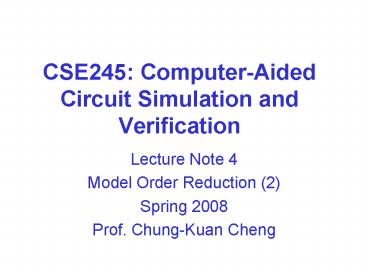CSE245: Computer-Aided Circuit Simulation and Verification PowerPoint PPT Presentation
Title: CSE245: Computer-Aided Circuit Simulation and Verification
1
CSE245 Computer-Aided Circuit Simulation and
Verification
- Lecture Note 4
- Model Order Reduction (2)
- Spring 2008
- Prof. Chung-Kuan Cheng
2
Model Order Reduction Overview
- Explicit Moment Matching
- AWE, Pade Approximation
- Implicit Moment Matching (Projection Framework)
- Krylov Subspace Methods
- PRIMA, SPRIM
- Gaussian Elimination
- TICER, Y-Delta Transformation
3
Conventional Design Flow
Parasitics resistance, capacitance and
inductance cause noise , energy consumption and
power distribution problem
Function Sepc
Beh. Simul
RTL
Logic Synth.
Stat. Wire Model
Gate-Lev. Sim
Gate-level Net.
Front-end
Back-end
Floorplanning
Para. Extraction
Place Route
Layout
4
Parasitic Extraction
R,L,C Extraction
Model Order Reduction
5
Moment Matching Projection method
- Key ideal of Model Order reduction
- Moments Matching and Projection
- Step1 identify internal state function and
variables. - Step2 Compose moments matching. (Pade, Taylor
expression). - Step3 Project matrix with matching moments.
(Block Arnoldi (PRIMA) or block Lanczos (PVL)) - Step4 Get the reduced state function.
6
Explicit V.S. Implicit Moment Matching
- Explicit moment matching methods
- Numerically ill-conditioned
- Implicit moment matching methods
- construct reduced order models through
projection, or congruence transformation. - Krylov subspaces vectors instead of moments are
used.
7
Congruence Transformation
- Definition
- Property Congruence transformation preserves
semidefiniteness of the matrix
8
Krylov Subspace
- Given an n x q matrix Vq whose column vectors are
v1, v2, , vq. The span of Vq is defined as
- Given an n x n matrix A and a n x 1 vector r the
Krylov subspace is defined as
9
PRIMA
- Passive Reduced-order Interconnect Macromodeling
Algorithm. - Krylov subspace based projection method
- Reduced model generated by PRIMA is passive and
stable.
PRIMA
(system of size q, qltltn)
(system of size n)
where
10
PRIMA
- step 1. Circuit Formulation
- step 2. Find the projection matrix Vq
- Arnoldi Process to generate Vq
11
PRIMA Arnoldi
12
PRIMA
- step 3. Congruence Transformation
13
PRIMA Properties
- Preserves passivity, and hence stability
- Matches moments up to order q (proof in next
slide)
- Original matrices A and C are structured.
- But and do not preserve this structure in
general
14
PRIMA Moment Matching Proof
Used lemma 1
15
PRIMA Lemma Proof
16
SPRIM
- Structure-Preserving Reduced-Order Interconnect
Macromodeling - Similar to PRIMA except that the projection
matrix Vq is different - Preserves twice as many moments as PRIMA
- Preserves structure
- Preserves passivity, stability and reciprocity
- Matching the same number of moment as PRIMA, but
preserve the structure which can reduced
numerical calculation.
17
SPRIM
- Recall
- Suppose Vq is generated by Arnoldi process as in
PRIMA. Partition Vq accordingly
- Construct New Projection Matrix
18
SPRIM
- Congruence Transformation
- Now structure is preserved
- Transfer function for the reduced order model
19
Traditional Y-? Transformation
- Conductance in series
- Conductance in star-structure
n0
n1
n2
n1
n2
n1
n1
n0
n3
n2
n2
n3
20
TICER (TIme Constant Equilibration Reduction)
- 1) Calculate time constant for each node
- 2) Eliminate quick nodes and slow nodes
- Quick node Eliminate if
- Slow node Eliminate if
- 3) Insert new Rs/Cs between former neighbors of
N - If nodes j and k had been connected to N through
gjN and gkN, add a conductance of value
gjNgkN/GN between j and k - If nodes j and k had been connected to N through
cjN and gkN, add a capacitor of value cjNgkN/GN
between j and k
21
TICER Issues
- Fill-in
- The order that nodes are eliminated matters
- Minimum Degree Ordering can be implemented to
reduce fill-in - May need to limit number of incident resistors to
control fill-in - Error control leads to low reduction ratio
- Accuracy
- Matches 0th moment at every node in the reduced
circuit. - Only Correct DC op point guaranteed

